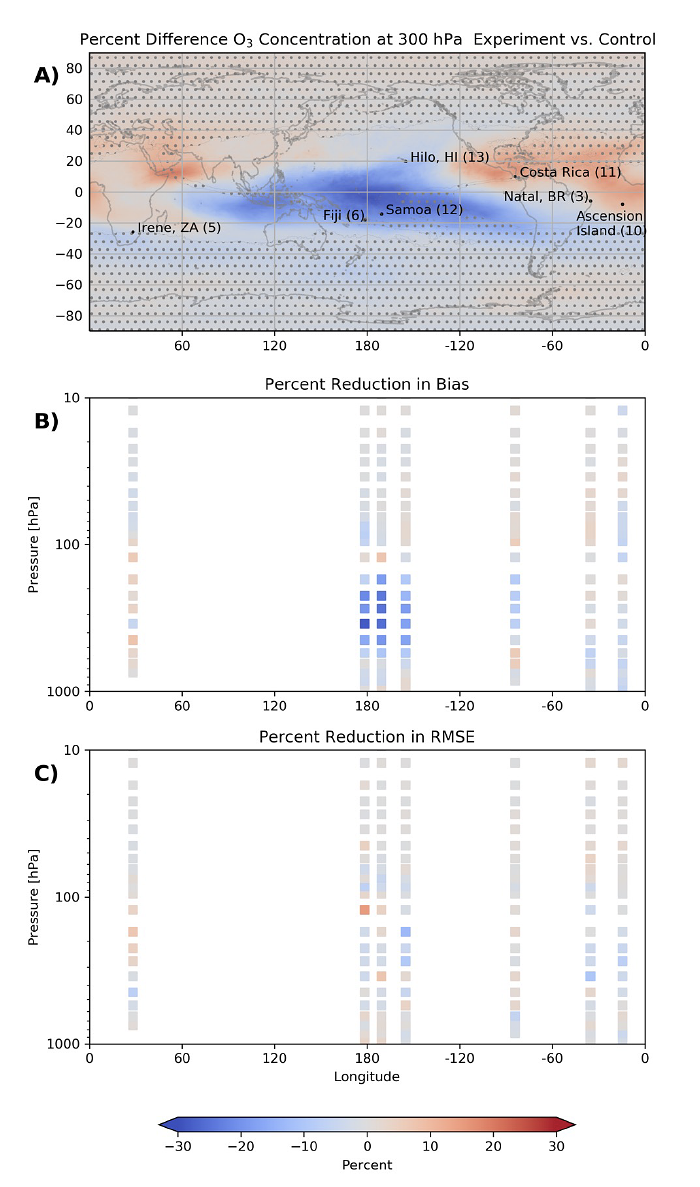Investigating the utility of hyperspectral sounders in the 9.6 μm Band to improve ozone analyses
Both tropospheric and stratospheric ozone play an important role in the Earth system, along with humanity’s survival within it. In the troposphere, near-surface ozone acts as an air pollutant, whereas in the stratosphere ozone serves to shield the Earth’s surface from ultraviolet radiation. NASA GMAO’s Modern-Era Retrospective analysis for Research and Applications version 2 (MERRA-2; Gelaro et al., 2017) combines conventional and satellite observations through successive six-hourly updates whereby information from previously ingested data is propagated forward in time by the general circulation model.
While MERRA-2 has been used to reliably determine ozone trends in stratosphere after some bias adjustments, Wargan et al. (2017) showed that MERRA-2 has a bias in the upper troposphere/lower stratosphere (UTLS) against ozonesondes. Radiances in the 9.6 μm band from AIRS and other hyperspectral sounders (CrIS, and IASI) are sensitive in the UTLS, and if assimilated could provide an improved data assimilation system for use in future NASA GMAO reanalysis efforts.
Two experiments using the Global Earth Observation System-Atmospheric Data Assimilation (GEOS-ADAS) system are conducted. The first assimilates 9.6 μm band from AIRS, CrIS and IASi in addition to the suite of observations assimilated, and a control experiment without assimilating 9.6 μm radiances. As shown in Figure 1, the percent difference in mean ozone concentration for August–September 2018 at 300 hPa between the experiment analysis and control (shown in Panel A) shows an enhancement of the tropical wave-1 ozone feature (stippling indicates significance below 95% confidence interval). In-situ ozonesonde observations available from SHADOZ (Thompson et al., 2017; Witte et al., 2017; 2018; Sterling et al., 2018) are used for validation purposes, and show an overall reduction in bias and RMSE in the UTLS (shown in blue in Panels B and C). The differences in the experiment and control analysis, verified against SHADOZ ozonesondes shows an improvement in the representation of the tropical wave-1 ozone feature, along with a reduction in overall bias and RMSE.
This work adds to the suite of NASA GMAO systems supporting a number of scientific applications. It has been added to the GEOS - Forward Processing system (GEOS-FP), where it provides better ozone information to NASA field campaigns, and science applications. The addition of 9.6 μm radiances will be included in future reanalyses where it is expected to reduce ozone biases in the UTLS. The addition of 9.6 μm radiances to the GEOS for Instrument Teams (GEOS-IT) could also improve the prior for ozone retrievals which utilize GEOS-IT in current and future missions including the Microwave Limb Sounder (MLS).
This snapshot is based on the results presented in Karpowicz et al. (2021).

References:
Gelaro, R., McCarty, W., Suárez, M.J., Todling, R., Molod, A., Takacs, L., Randles, C.A., Darmenov, A., Bosilovich, M.G., Reichle, R.,Wargan, K., Coy, L., Cullather, R., Draper, C., Akella, S., Buchard, V., Conaty, A., da Silva, A.M., Gu, W., Kim, G.K., Koster, R., Lucchesi, R., Merkova, D., Nielsen, J.E., Partyka, G., Pawson, S., Putman, W., Rienecker, M., Schubert, S.D., Sienkiewicz, M.and Zhao, B. (2017) The Modern-Era Retrospective analysis for Research and Applications, version 2 (MERRA-2). Journal of Climate, 30, 5419–5454.
Karpowicz, B. M., McCarty, W., and Wargan, K. (2021). Investigating the utility of hyperspectral sounders in the 9.6 μm band to improve ozone analyses. Quarterly Journal of the Royal Meteorological Society. https://doi.org/10.1002/qj.4198.
Thompson, A.M., Witte, J.C., Sterling, C., Jordan, A., Johnson,B.J., Oltmans, S.J., Fujiwara, M., Vömel, H., Allaart, M., Piters,A., Coetzee, G.J., Posny, F., Corrales, E., Diaz, J.A., Félix, C.,Komala, N., Lai, N., Ahn Nguyen, H.T., Maata, M., Mani, F., Zainal, Z., Ogino, S.Y., Paredes, F., Penha, T.L.B., da Silva, F.R., Sallons-Mitro, S., Selkirk, H.B., Schmidlin, F.J., Stübi, R. and Thiongo, K. (2017) First reprocessing of Southern Hemisphere Additional OZonesondes (SHADOZ) ozoneprofiles (1998–2016): 2. Comparisons with satellites and ground-based instruments. Journal of Geophysical Research: Atmospheres, 122, 13000–13025. https://doi.org/10.1002/2017JD027406.
Wargan, K., Labow, G., Frith, S., Pawson, S., Livesey, N. and Partyka, G. (2017) Evaluation of the ozone fields in NASA’s MERRA-2 reanalysis. Journal of Climate, 30, 2961–2988.
Witte, J.C., Thompson, A.M., Smit, H.G., Fujiwara, M., Posny,F., Coetzee, G.J., Northam, E.T., Johnson, B.J., Sterling, C.W., Mohamad, M., Ogino, S.Y., Jordan, A. and da Silva, F.R. (2017) First reprocessing of Southern Hemisphere ADditional OZonesondes (SHADOZ) profile records (1998-2015): 1. Methodology and evaluation. Journal of Geophysical Research; Atmospheres, 122, 6611–6636. https://doi.org/10.1002/2016JD026403.
Witte, J.C., Thompson, A.M., Smit, H.G., Vömel, H., Posny, F. and Stübi,R. (2018) First reprocessing of Southern Hemisphere ADditional OZonesondes profile records: 3. Uncertainty in ozone profile and total column. Journal of Geophysical Research: Atmospheres, 123, 3243–3268.


